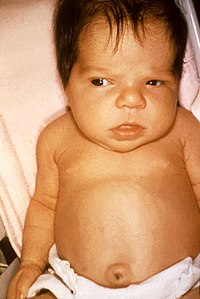
Photo from wikipedia
The clinical consequences of defective primary cilium (ciliopathies) are characterized by marked phenotypic and genetic heterogeneity. Although fibrocystic liver disease is an established ciliopathy phenotype, severe neonatal cholestasis is rarely… Click to show full abstract
The clinical consequences of defective primary cilium (ciliopathies) are characterized by marked phenotypic and genetic heterogeneity. Although fibrocystic liver disease is an established ciliopathy phenotype, severe neonatal cholestasis is rarely recognized as such. We describe seven individuals from seven families with syndromic ciliopathy clinical features, including severe neonatal cholestasis (lethal in one and necessitating liver transplant in two). Positional mapping revealed a single critical locus on chromosome 7. Whole exome sequencing revealed three different homozygous variants in TTC26 that fully segregated with the phenotype. TTC26 (IFT56/DYF-13) is an atypical component of IFT-B complex, and deficiency of its highly conserved orthologs has been consistently shown to cause defective ciliary function in several model organisms. We show that cilia in TTC26-mutated patient cells display variable length and impaired function as indicated by dysregulated sonic hedgehog signaling (SHH), abnormal staining for IFT-B components and transcriptomic clustering with cells derived from individuals with closely related ciliopathies. We also demonstrate a strong expression of Ttc26 in the embryonic mouse liver in a pattern consistent with its proposed role in the normal development of the intrahepatic biliary system. In addition to establishing a TTC26-related ciliopathy phenotype in humans, our results highlight the importance of considering ciliopathies in the differential diagnosis of severe neonatal cholestasis even in the absence of more typical features.
Journal Title: Hepatology
Year Published: 2019
Link to full text (if available)
Share on Social Media: Sign Up to like & get
recommendations!